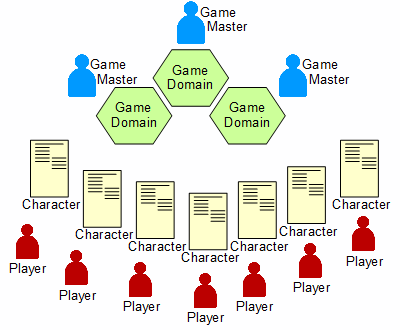These concepts are built from Justin Alexander’s Open Table Manifesto and over a year of practical application.
The aim of the open table format is for casual play by the participants. People may show up for a session, play, and then may show up to the next or not. The public sessions are regular but attendance is not expected of any member. Game masters have the only pressure to attend, at least enough of them to allow some play. To achieve this flexibility a number of things are required.

- All GMs have their own domain, but each domain is a part of a single setting.
- All players at the start of a session each join a table where a GM has space, so the number of players for each GM is roughly equal.
- Play in each GMs domain begins and ends in the same location every session.
- Time in the game is synchronised across all GM domains at the start of the session. The gap in time within the game setting, between the start of one session and the next, is mapped to the gap in time in real life between sessions.
- The rules for the game being played are assumed to be vanilla and only those variations agreed on by all GMs can be used. This makes player characters moving from one GM domain to another easily compatible.
- Game masters create living domains rather than proscribed adventures.
- Players keep and manage their character sheets, while GMs keep and manage their domains.
- GMs negotiate cross domain world events and interactions as they see fit.
- Adventure design cannot assume the same group of players will be involved in multiple sessions to complete them. It is preferable for any particular situation to be able to be dealt with in some satisfactory way in a single session.
Time

The mapping of “real life” days to “in game” days is the most important feature to understand. In the diagram above, in real life the sessions are two weeks apart. However each real day is mapped to two game days, so the start of the next session is 4 weeks from the start of the current session in game terms.
During the current session the players are shown to have adventured out from their home location, adventured for a few days and then returned to their home location over 11 game days. At the start of the next adventure this means the players need to account for 17 game days worth of down time.
Note that session in each game master’s domain, play may have covered different numbers of in game days in the same session. Gail’s group may have played out 12 days, while Tim’s group played out 20 days, and so on.
The open table should have some rules around how to account for “between play” down time. This is useful time for study, crafting, research and so on. It should avoid becoming a major adventure item, however. Anything that requires interesting role play is reserved for actual adventure time.
Also note that players that skip one or more sessions will need to account for longer down time periods. To handle this each player character has a log sheet, noting the date in game terms at the start and end of their session. When they next play they note the start date in game terms for the current session and just calculate the difference from their last logged in game date.
GM Domains
Game masters cannot assume group continuity and cannot allow session participants to remain “out there” at the end of the session. At the next session all characters need to be able to start a new adventure from whichever GM’s domain they find themselves in.
Information about what has been happening recently in a GM’s domain should be made readily available to all participants at a session so they can get a feel for what is going on and launch themselves into the next adventure.
To make this easy for the GMs there should be a live setting within their domain. As players do things then the setting changes. Major NPCs fortunes come and go, their plans are foiled or successful, new NPCs may enter the fray while old ones fade out or are taken out.

Pingback: Constructing an Open Table Campaign for D&D 5e: An update – Strange Flight
Pingback: Constructing an Open Table Campaign for D&D 5e part 3 – Strange Flight
Pingback: Constructing an Open Table Campaign for D&D 5e part 2 – Strange Flight
Pingback: Constructing an Open Table Campaign for D&D 5e part 1 – Strange Flight
Pingback: Combat Toolkit Nears Completion – All Us Gamers Role Playing Game